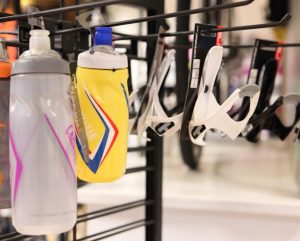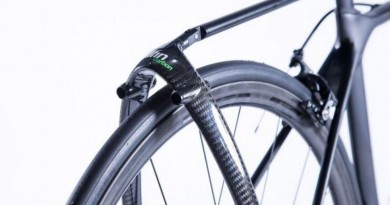Sales Agent’s view: 10 ways to design customer engagement into your bike shop
CyclingIndustry.News is today pleased to introduce to you another regular contributor – bike trade sales agent and author John Styles.
Here he outlines some observations from his travels around bike stores, detailing how shop owners can learn from the ghosts of the High Street past in order to drive customer engagement:
In March 2016 we learned that BHS would be joining the long list of High St failures, while WH Smith posted an £80m profit for the six month period ending February 2016 – up 11% on the previous year. I’d like to explain some of the deep-seated reasons behind their long term survival and perhaps how you can borrow a leaf or two from “the WHS book” to help your store. I want you to survive too.
If you work in, or own, a cycle store in the UK, chances are there’s a WH Smith within a mile or two. Not a Woolworths, Borders, Blockbuster, HMV, Jessops, Comet, JJB Sports, Peacocks, MFI, C&A or…. BHS. A WH Smith. Or possibly two, if you have a hospital, station or airport nearby. Now did you ever stop and wonder why? Why, when all about were closing, WH Smith survived?
So the last 10 years has been pretty rough in High St retail, but WHS survived because back in 2006 they made a plan. A simple plan called “Sell More Stuff”. Not “excelling at customer centric paradigm shifts” or other such corporate nonsense. Sell More Stuff. And, from what I heard, the bones of it went something like this:
“The internet is getting stronger and the High St is under pressure. There isn’t room for Borders, Woolworths and WH Smith…….When I look around our stores I see a lot of fresh air. We can’t sell fresh air…..we are going to pack more into our stores… new racking and fixtures will increase our product density…Our suppliers are going to help us by producing smaller and more uniform packaging sizes….We need quality merchandise and good value to drive footfall…. Our suppliers will help with compelling offers….And when the consumer comes in for a book or an ink cartridge or whatever else… they will leave with additional purchases in their basket too, we will drive basket spend with impulse siting”.
And because this plan was simple no-nonsense retailing, much of it is easily applicable in your store. Should you wish. Go take a look around your local WHS. Notice the racking, floor to ceiling merchandise. Massive category signs for easy navigation. Sub navigation signs within categories. An incredible array of impulse items, not only at the till, but on your journey to the till too (in my local WHS there’s chocolate or sweets in every aisle that returns to the till). So, you went in for a birthday card and a book. You came out with a birthday card, book, wrapping paper, packet of felt tips, magazine gift subscription, 1/2 price slab of chocolate, chewing gum and a dot-dot stress therapy colouring book.
As an independent retailer, your store will reflect your local customer base and to some extent be an extension of your personality. Your way of doing things. It won’t be uniform, or planno-grammed within an inch of its life. Who wants to be “big corporate”, right? Yes, but there may be things we can we learn, or borrow or adapt from their way of doing things?
So, based on my observations of their retailing model (and other multiples naturally) I’ve come up with a simple “WHS Test” for independent bicycle stores. It focuses on 10 key consumer interaction points, in the order in which they occur.
- Footfall driver: What brings consumers to your store in the first place? In WHS it’s something like an ink cartridge, revision guide or half price book. Do you know your key drivers? Do you have a plan? Is there anything else you could do to make more people visit more often?
- Shopfront signage: WHS stores have both a main board for “across the street” and 90 degree boards for “along the street”. Of the 600+ bicycle stores I’ve visited, I guess only a fraction have the second type of sign.
- Doors: Are they big and wide? Do they open by themselves? That’s what WHS (and other big retailers) offer their consumers. And their customers are coming in empty handed. Yours are often manhandling a bicycle…would an automatic sliding door be a helpful gesture and perhaps one less barrier?
- Navigation Signage: When the consumer has “landed” about 4-5 paces inside a WHS store, she
 can easily see all the major category signage. Just visit a store and watch this happening. In, pause, sight, move. What often happens in a bicycle store? In, pause, frown, ask question… “Where’s the… Do you sell…?” You might think the pumps or tyres are easy to spot because you see them every day. Your consumers don’t. It’s not right for every style of store, but I only know two bicycle stores who do this well. Two.
can easily see all the major category signage. Just visit a store and watch this happening. In, pause, sight, move. What often happens in a bicycle store? In, pause, frown, ask question… “Where’s the… Do you sell…?” You might think the pumps or tyres are easy to spot because you see them every day. Your consumers don’t. It’s not right for every style of store, but I only know two bicycle stores who do this well. Two. - Fresh air count: You can’t sell fresh air. If your displays are gappy, then you either need a smaller store for the product you have, or more product for the store space you have. That piece of wall space has the same overhead whether you fill it or not. It has to pay its way. And key to that is product density.
- Merchandising density and clarity: You need to fit in as much as you can. But not at the expense of clarity. That’s why blocks of single brands work well, especially with their own POS. Again, take a look around WHS. How much space is there between products? It’s no more than 5mm in many cases. And yet, it’s not the “jumble sale” that was part of Woolies downfall.
- Till location: At the front. Your customer goes to the back for the planned purchase, then journeys to the front grabbing impulse and distress lines as they go.
- Till Queue Merchandising: Have you studied where people stand and what they look at when
the till queue gets busy? Perhaps not as you were too busy behind the till? If you observe this, you could create your own till queue merchandising channel, where people can grab extra items while they wait. WHS are good at this, but the best examples are the petrol forecourts. They have to be, as since Esso price watch arrived in 1996, there’s been very little profit in retailing the fuel itself. So maybe take a look around when you’re next in BP or Shell. Coffee cup (on the counter!) metres of chocolate, water, sandwich, shiny torch, Thinsulate gloves. All within (a scientifically calculated) grabbing distance, so you don’t lose your place in the queue. - Impulse Lines: Have a look which categories surround a WHS till area. Now think about what are the most impulsive lines in your store? Are they all represented at the till – even just one SKU from the range? They could even be dual sited, for example, puncture patches, co2 cans, energy bars, multi tool etc next to their own category and also by the till
- Return visit vouchers: Finally, I’ve paid for my goods and I walk away with a bunch of vouchers. £5 off when I spend £25 next time. Buy 1 get 1 half price on any an ink cartridge. Free this when I buy that. WHS want you back, after all, the No. 1 challenge in today’s High St is footfall (which is why they are now partnering with Post Office – it’s a footfall driver). And isn’t footfall your No.1 issue too? Now in the bicycle trade, it’s commonplace to get a consumer back after 6 weeks when they buy a bicycle, the first free service/safety check. But what about all those other times they came in store? For a repair, for clothing, for P&A. I bet your EPOS system has some whizzy options for adding offers and vouchers to receipts. Why not check it out or run a small scale trial? You can but try.
Many independent stores are already very successful of  course and won’t need this sort of advice. Meanwhile, others are so stressed and struggling to keep up they probably won’t have time to read this. Which leaves a small band in the middle ground. (Hi there!) Your store is doing kind of okay, but you’d like to do better, you want to be more WHS and less BHS. Yes?
course and won’t need this sort of advice. Meanwhile, others are so stressed and struggling to keep up they probably won’t have time to read this. Which leaves a small band in the middle ground. (Hi there!) Your store is doing kind of okay, but you’d like to do better, you want to be more WHS and less BHS. Yes?
For my part, as an independent sales agent, my survival depends on yours. So, I wish you the best of luck with any ideas you can grab from the list and “make your own”. Chances are though, some of the above is limited by your current layout, premises or lease. So if you end up moving, refurbishing, extending, or opening another store, maybe bookmark this page, or drop me a line for a chat when the time comes. After all, man makes his environment and thereafter, it makes him.
About John:
Having spent 20 years working in the retail/wholesale distribution chain with companies like Palmer and Harvey, Parker Pen, Madison, Zyro and Windwave, as well as authoring numerous bike shop advice articles, Jon has a wealth of experience. He’s been a Marketing Manager, Brand Manager and Product Manager but nowadays prefers to spend his time “on the front line” as an Independent Sales Agent covering London and the South East. John has visited over 600 stores in the UK, plus a variety of stores in other countries including France, Spain, Holland, Belgium, the USA and Canada. He also consults for brands who are seeking UK distribution partners or advice on the UK market.



